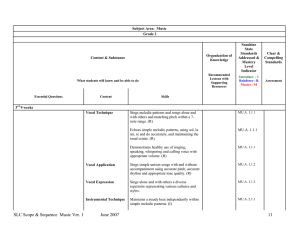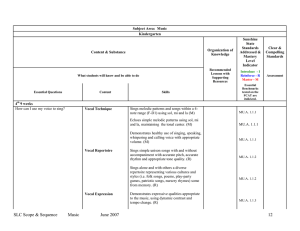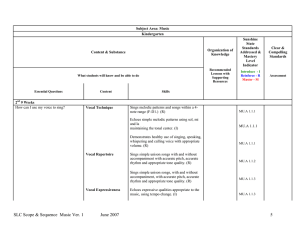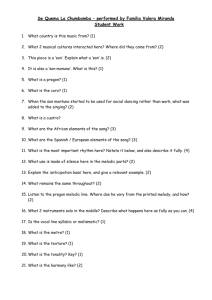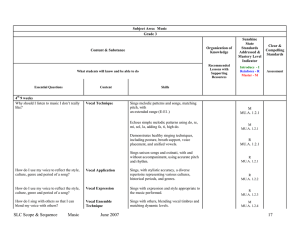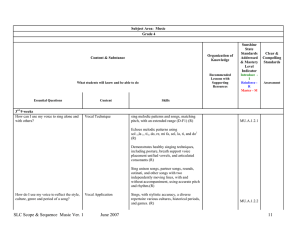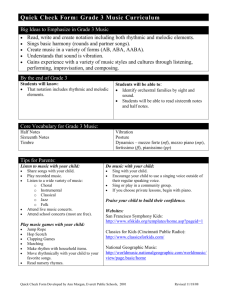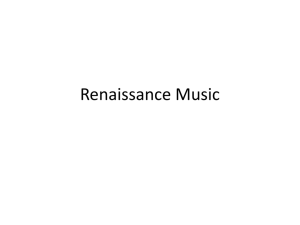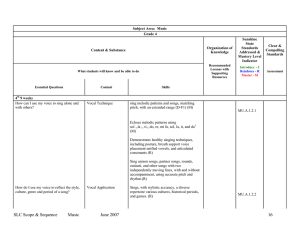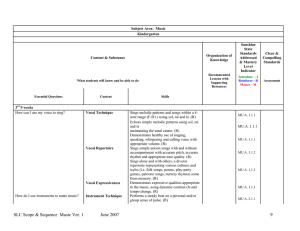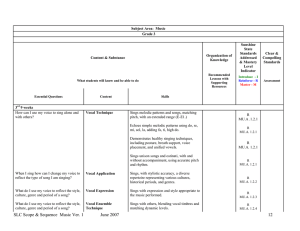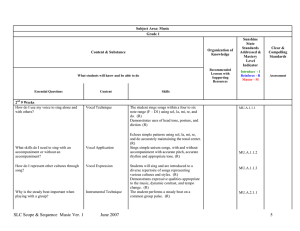Document 11061263
advertisement
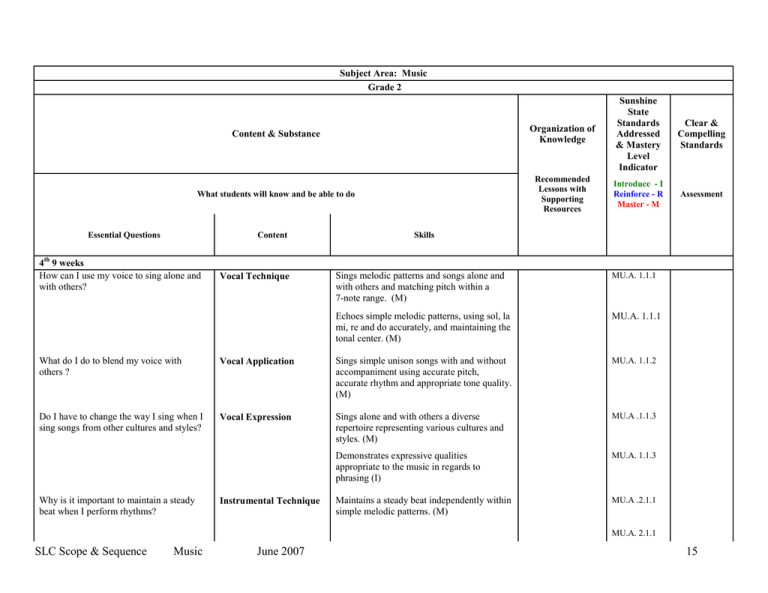
Subject Area: Music Grade 2 Content & Substance Organization of Knowledge Sunshine State Standards Addressed & Mastery Level Indicator What students will know and be able to do Recommended Lessons with Supporting Resources Introduce - I Reinforce - R Master - M Essential Questions Content 4th 9 weeks How can I use my voice to sing alone and with others? Vocal Technique Sings melodic patterns and songs alone and with others and matching pitch within a 7-note range. (M) MU.A. 1.1.1 Echoes simple melodic patterns, using sol, la mi, re and do accurately, and maintaining the tonal center. (M) MU.A. 1.1.1 Vocal Application Sings simple unison songs with and without accompaniment using accurate pitch, accurate rhythm and appropriate tone quality. (M) MU.A. 1.1.2 Do I have to change the way I sing when I sing songs from other cultures and styles? Vocal Expression Sings alone and with others a diverse repertoire representing various cultures and styles. (M) MU.A .1.1.3 Demonstrates expressive qualities appropriate to the music in regards to phrasing (I) MU.A. 1.1.3 Maintains a steady beat independently within simple melodic patterns. (M) MU.A .2.1.1 Instrumental Technique Assessment Skills What do I do to blend my voice with others ? Why is it important to maintain a steady beat when I perform rhythms? Clear & Compelling Standards MU.A. 2.1.1 SLC Scope & Sequence Music June 2007 15 Subject Area: Music Grade 2 Content & Substance Organization of Knowledge Sunshine State Standards Addressed & Mastery Level Indicator What students will know and be able to do Recommended Lessons with Supporting Resources Introduce - I Reinforce - R Master - M Essential Questions Content Clear & Compelling Standards Assessment Skills 4th 9 weeks Echoes rhythmic patterns using quarter notes, two eighth notes (M), and quarter rests (M), half notes and half rests (R). ???????? Maintain a simple melodic pattern on instruments in combination with other patterns to accompany poems, chants, and songs, and stories (I). When I play an instrument, how can I change the way it sounds to match the music I am playing? Instrumental Application Demonstrates expressive qualities of dynamics and tempo appropriate to the music while playing classroom and ethnic instruments. (R) MU.A.2.1.2 How does notation represent what I hear and play? Notation Reads and performs quarter note, 2 eight note (M) quarter rest (M), half notes, and half rest (R) rhythmic patterns. MU.A. 3.1.1 Reads and performs simple melodic patterns from traditional and non traditional notation using pentatonic scale (R). MU.A. 3.1.3 Writes notation using manipulative and visual representation for simple melodic patterns using sol, la, mi (I). MU.A. 3.1.2 Pitch SLC Scope & Sequence Music June 2007 16 Subject Area: Music Grade 2 Content & Substance Organization of Knowledge Sunshine State Standards Addressed & Mastery Level Indicator What students will know and be able to do Recommended Lessons with Supporting Resources Introduce - I Reinforce - R Master - M Essential Questions Content 4th 9 weeks When I hear a musical phrase, how can I create my own phrase to compliment the one I hear? How can I create my own patterns to go along with a song, poem or story? Improvises melodic “answer phrases” in the same style as “question” phrases (I). MU.B. 1.1.1 Improvisation: Accompaniment Improvises melodic patterns to accompany songs, poems, or stories (I). MU.B .1.1.2 Composition Creates simple accompaniments using classroom instruments for songs, poems, and stories (R). MU.B. 2.1.1 How can I move my body to represent the changes of the shape of the music? Critical Analysis: Movement Responds to the melodic contour of a phrase, and form by using purposeful movement (R). MU.D. 1.1.1 When I hear or see an instrument, how can I tell what it is and to what family it belongs? Critical Analysis: Aural Differentiation Classifies classroom instruments by sound source when presented visually and aurally (I). Classifies instrument by family when presented both visually and aurally (I). MU.D. 1.1.2 Describes specific characteristics of melodic contour, and form (I). MU.D. 1.1.3 Describes how expressive qualities are used to convey feelings, images, moods, and events through music (R.). MU.D. 1.1.4 SLC Scope & Sequence Music Critical Analysis: June 2007 Assessment Skills Improvisation: Q & A How can I describe the music I hear and play? Clear & Compelling Standards MU.D. 1.1.2 17 Subject Area: Music Grade 2 Content & Substance Organization of Knowledge Sunshine State Standards Addressed & Mastery Level Indicator What students will know and be able to do Recommended Lessons with Supporting Resources Introduce - I Reinforce - R Master - M Essential Questions Content Clear & Compelling Standards Assessment Skills 4th 9 weeks How should I behave when I am attending a performance? SLC Scope & Sequence Music Life Applications: The Arts Demonstrates basic understanding of how concepts within and among music, theater, musical arts, and dance are similar (I). MU.E .1.1.1 Life Application: CrossCurricular Connections Identifies ways in which Language Arts, Math, Social Studies, and Science relate to music (R). MU.E. 1.1.2 Life Application: Audience Etiquette Demonstrates appropriate audience behavior in such settings as classroom, school, public performance (R). MU.E .2.1.2 June 2007 18
